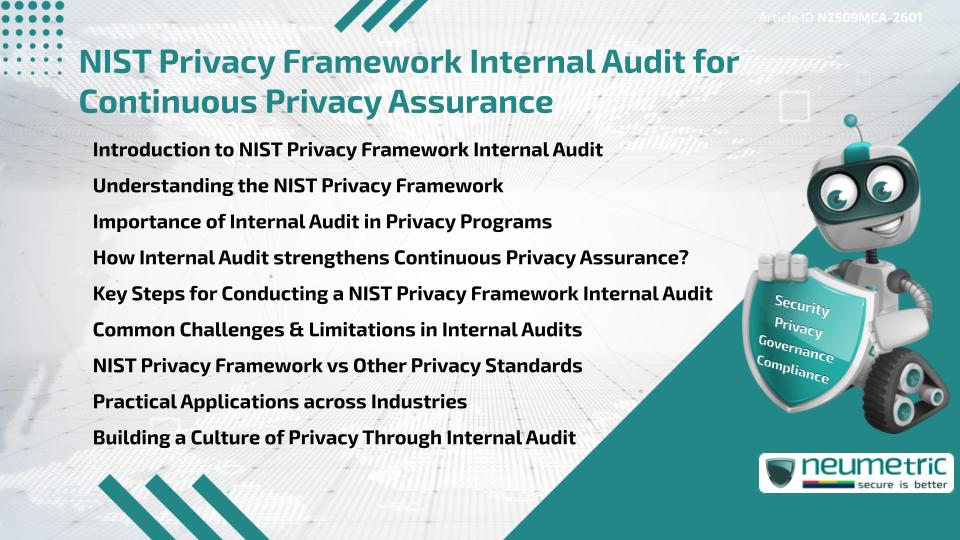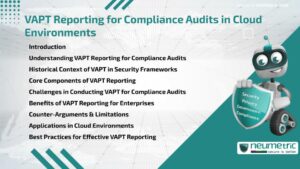Table of Contents
ToggleIntroduction to NIST Privacy Framework Internal Audit
The NIST Privacy Framework Internal Audit for Continuous Privacy Assurance is a critical process that helps Organisations evaluate how effectively they protect Personal Information. This type of Audit examines the alignment between existing Privacy practices & the principles of the National Institute of Standards & Technology [NIST] Privacy Framework. It ensures that Privacy Risks are managed, Controls are implemented & Compliance is maintained. More importantly, it offers continuous assurance that Privacy safeguards are not just documented but actively working in practice.
Understanding the NIST Privacy Framework
The NIST Privacy Framework is a voluntary tool designed to help Organisations identify, assess & manage Privacy Risks. It provides a structured approach, similar to the well-known NIST Cybersecurity Framework, but focuses specifically on Personal Data & individual Privacy. The Framework has three main components: Core, Profiles & Implementation Tiers. The Core outlines activities such as identifying Risks, governing Policies, Controlling data & responding to Incidents. Profiles allow Organisations to tailor the Framework to their needs, while Implementation Tiers show the maturity level of Privacy practices.
Importance of Internal Audit in Privacy Programs
Internal Audits serve as a mirror that reflects how well Privacy Controls are functioning. Without them, Organisations may rely only on assumptions about Compliance. A NIST Privacy Framework Internal Audit provides Evidence-based findings on whether Policies are followed, Risks are addressed & staff are trained. Just as a health check-up helps detect underlying issues, an Internal Audit uncovers gaps in Privacy Governance before they become major problems.
How Internal Audit strengthens Continuous Privacy Assurance?
Continuous Privacy assurance means that Privacy is not treated as a one-time project but as an ongoing commitment. Internal Audits reinforce this commitment by offering regular & structured Reviews. For example, they help detect whether new technologies introduce fresh Risks or if Third Party Vendors comply with Privacy requirements. This proactive approach reduces the chances of Breaches & builds Trust with Customers, Employees & Regulators. According to NIST guidelines, routine checks are essential to adapt to evolving Risks & maintain Resilience.
Key Steps for Conducting a NIST Privacy Framework Internal Audit
Conducting a NIST Privacy Framework Internal Audit involves a clear sequence of steps:
- Planning: Define the Scope, Objectives & Privacy domains to be examined.
- Data Collection: Gather Policies, Processes, System Logs & Interview feedback.
- Assessment: Compare current practices against the NIST Privacy Framework Core.
- Testing Controls: Verify whether safeguards, such as access restrictions, function effectively.
- Reporting: Document findings, highlight Risks & recommend Corrective Actions.
- Follow-up: Ensure that management addresses the gaps & tracks improvements.
These steps provide a cycle of improvement that strengthens both Compliance & resilience.
Common Challenges & Limitations in Internal Audits
While Audits are essential, they face challenges. One limitation is resource constraints. Smaller Organisations may lack trained staff to perform comprehensive Audits. Another issue is scope creep, where Audits become too broad & lose focus. Resistance from Employees can also reduce effectiveness, especially if they view Audits as intrusive. Moreover, Internal Audits may not cover every external Risk, such as Third Party data misuse. Balancing thoroughness with practicality remains a key challenge.
NIST Privacy Framework vs Other Privacy Standards
The NIST Privacy Framework is not the only tool available. Internationally, regulations such as the General Data Protection Regulation [GDPR] & the California Consumer Privacy Act [CCPA] also set Privacy requirements. Unlike these laws, the NIST Privacy Framework is voluntary, but it provides a flexible structure that can complement Regulatory Compliance. In contrast, frameworks such as ISO/IEC 27701 focus on specific management systems. By comparing these approaches, Organisations can select the best combination to meet both Legal & Ethical Standards.
Practical Applications across Industries
The flexibility of the NIST Privacy Framework allows it to be applied across diverse industries. In Healthcare, it supports Compliance with Patient Data regulations such as HIPAA. In Financial services, it helps manage Risks related to sensitive Client data. Technology companies use it to review how apps handle User information. Regardless of industry, a NIST Privacy Framework Internal Audit ensures that Organisations embed Privacy into everyday operations.
Building a Culture of Privacy Through Internal Audit
Ultimately, internal Audits go beyond Compliance checklists. They foster a culture where Privacy becomes part of organisational values. Employees begin to understand that Privacy is not just a Legal requirement but a responsibility toward individuals whose data they handle. Regular Audits reinforce this mindset, leading to better Practices, stronger Accountability & enhanced Trust.
Conclusion
A NIST Privacy Framework Internal Audit for Continuous Privacy Assurance is not simply a regulatory exercise. It is a powerful tool to measure, improve & sustain Privacy practices. By embedding Audits into routine Governance, Organisations demonstrate Accountability & maintain Resilience in a world where Personal Data is constantly at Risk.
Takeaways
- A NIST Privacy Framework Internal Audit validates Privacy safeguards.
- It ensures continuous assurance through regular evaluation.
- Internal Audits help address Risks, Compliance & Governance gaps.
- They encourage a culture of Privacy across the Organisation.
FAQ
What is a NIST Privacy Framework Internal Audit?
It is a structured evaluation of an organisation’s Privacy practices against the NIST Privacy Framework to ensure Risks are managed & Controls are effective.
Why is continuous Privacy assurance important?
It ensures that Privacy safeguards are regularly tested & updated, reducing Risks of breaches & building Trust with Stakeholders.
How often should Organisations conduct an Internal Audit?
Most Organisations conduct Audits annually, but high-Risk industries may benefit from quarterly or semi-annual Audits.
Can a Small Business use the NIST Privacy Framework?
Yes, the Framework is designed to be flexible & scalable, making it suitable for Small Businesses as well as large enterprises.
How does the NIST Privacy Framework differ from GDPR?
GDPR is a binding law in the European Union, while the NIST Privacy Framework is a voluntary tool. However, the Framework can support GDPR Compliance efforts.
What challenges do internal Audits face?
They often encounter resource shortages, Employee resistance & difficulty in covering external Risks such as Third Party data misuse.
Are internal Audits only about Compliance?
No, they also promote Continuous Improvement, detect Risks early & strengthen organisational culture around Privacy.
Need help for Security, Privacy, Governance & VAPT?
Neumetric provides organisations the necessary help to achieve their Cybersecurity, Compliance, Governance, Privacy, Certifications & Pentesting needs.
Organisations & Businesses, specifically those which provide SaaS & AI Solutions in the Fintech, BFSI & other regulated sectors, usually need a Cybersecurity Partner for meeting & maintaining the ongoing Security & Privacy needs & requirements of their Enterprise Clients & Privacy conscious Customers.
SOC 2, ISO 27001, ISO 42001, NIST, HIPAA, HECVAT, EU GDPR are some of the Frameworks that are served by Fusion – a SaaS, multimodular, multitenant, centralised, automated, Cybersecurity & Compliance Management system.
Neumetric also provides Expert Services for technical security which covers VAPT for Web Applications, APIs, iOS & Android Mobile Apps, Security Testing for AWS & other Cloud Environments & Cloud Infrastructure & other similar scopes.
Reach out to us by Email or filling out the Contact Form…





